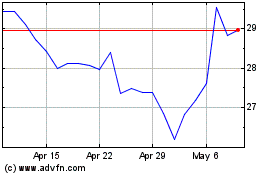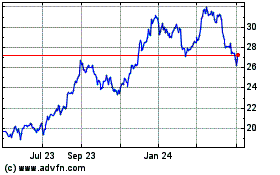Swiss Lawmakers to Vote on New Rules for UBS, Credit Suisse
September 15 2015 - 2:50PM
Dow Jones News
ZURICH—Swiss lawmakers may deliver a sharp reminder to the
country's biggest banks, UBS Group AG and Credit Suisse Group AG,
that they remain under close scrutiny at home.
On Wednesday, one chamber of Switzerland's parliament is
expected to vote on proposed rules for the two Zurich-based global
lenders, including a mandatory separation of their relatively risky
investment banking units from other operations.
Other proposals include requiring the banks to hold the
equivalent of as much as 10% of their loans and investments in the
form of a capital buffer. Currently, Switzerland's big banks are
required to maintain such so-called leverage ratios of slightly
more than 4%.
The votes are part of a broader Swiss reconsideration of
stability requirements for UBS and Credit Suisse. The country's
Department of Finance is expected to issue its own proposed new
rules for the banks, including a higher leverage ratio requirement,
by the end of this year.
The shifting regulatory landscape reflects the sentiment that
several years after the financial crisis, tiny Switzerland has yet
to properly insulate itself from a failure of one of its banking
giants. UBS received a government bailout in 2008, after racking up
some $50 billion in losses. The traumatic rescue drew the ire of an
alarmed Swiss public and policy makers.
UBS and Credit Suisse have each significantly bolstered their
respective capital cushions recently, and launched restructuring
intended to prevent trouble at one part of a bank from damaging the
entire entity. But skepticism remains.
"We're still watching the banks," said Thomas Aeschi, a member
of the Swiss People's Party. He said the proposals are a way of
"keeping the pressure up."
If the proposals are approved on Wednesday, they could
eventually be passed on for consideration by the seven councilors
who make up the country's executive branch.
The proposals are supported by an unlikely alliance between Mr.
Aeschi's right-wing party and the left-wing Social Democrats. The
parties have a combined majority in the larger of the two chambers
of parliament.
The Social Democrats are supporting a proposal put forward by
Mr. Aeschi for a 6% leverage ratio requirement, while the Swiss
People's Party is supporting the other party's motion to require a
splintering off of investment banking from businesses like
commercial banking.
Mr. Aeschi said his party isn't supporting a separate proposal
from the Social Democrats for a 10% leverage ratio requirement,
which is also expected to see a vote.
Luciano Ferrari, the head of policy for the Social Democrats,
suggested that the support from his right-wing counterparts for
tougher banking rules stems partly from an ugly historical episode
for the guiding force behind that party: billionaire Christoph
Blocher.
Mr. Blocher was ousted from the board of directors at Union Bank
of Switzerland, which later merged with another bank to form UBS,
in 1992.
Mr. Blocher brushed aside any notion of regulatory revenge. "I'm
not against the big banks," he said. But Mr. Blocher said the issue
of bank stability is particularly pressing in Switzerland, where
the combined balance sheets of UBS and Credit Suisse are far larger
than the country's economy. That could make bailing them out
particularly painful. UBS Chief Executive Sergio Ermotti has
dismissed that notion, telling The Wall Street Journal in July that
it is merely " a way to scare people."
Mr. Ermotti's outspokenness has raised some eyebrows. "They'd
become a bit modest after the crisis," Mr. Ferrari said of the big
banks, "But they're both now back to their old way of
thinking."
Spokesmen for UBS and Credit Suisse declined to comment.
Write to John Letzing at john.letzing@wsj.com
Subscribe to WSJ: http://online.wsj.com?mod=djnwires
(END) Dow Jones Newswires
September 15, 2015 14:35 ET (18:35 GMT)
Copyright (c) 2015 Dow Jones & Company, Inc.
UBS (NYSE:UBS)
Historical Stock Chart
From Mar 2024 to Apr 2024

UBS (NYSE:UBS)
Historical Stock Chart
From Apr 2023 to Apr 2024
